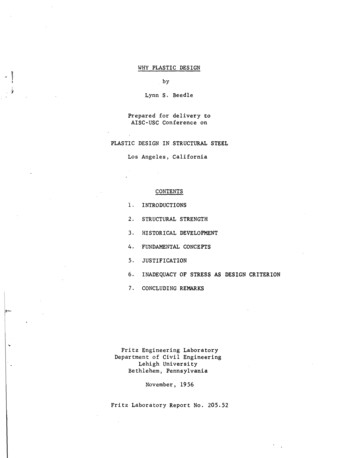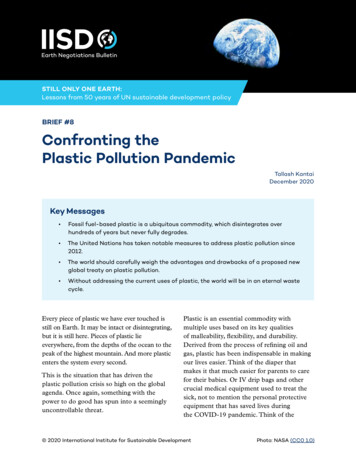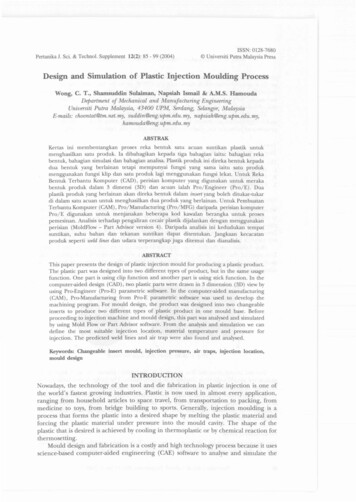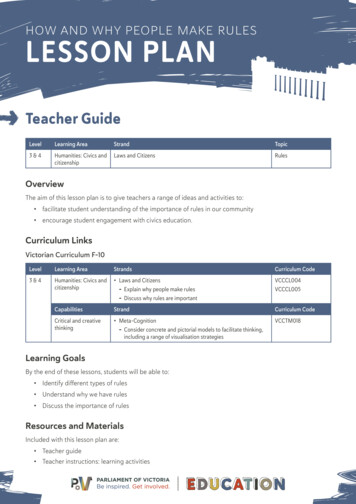
Transcription
WHY PLASTIC DESIGNbyLynn S. BeedlePrepared for delivery toAISC-USC Conference onPLASTIC DESIGN IN STRUCTURAL STEELLos Angeles, CaliforniaCONTENTS1.INTRODUCTIONS2.STRUCTURAL STRENGTH3.HISTORICAL DEVELOPMENT4.FUNDAMENTAL CONCEPTS5.JUSTIFICATION6.INADEQUACY OF STRESS AS DESIGN CRITERION7.CONCLUDING REMARKSFritz Engineering LaboratoryDepartment of Civil EngineeringLehigh UniversityBethlehem, PennsylvaniaNovember, 1956Fritz Laboratory Report No. 205.52
-11. I N T ROD U C T IONSteel possesses ductility--A unique property that no other structuralmaterial exhibits in quite the same way.Through .ductility structural steel isable to absorb large deformations beyond the elastic limit without thedange of fracture.Although there are a few instances where conscious use has been madeof this property, by and large the engineer has not been able to fully exploitthis eature·of ductility instructural steel.As a result of these imitationsit turns out that we have been making a considerable sacrifice of economy.Engineers have k0 . wn of this ductility for years, and since the 1920'shave been attempting to see if some conscious use couldn't be made of thisproperty in design.Plastic design is the realization of that goal.We arenow equipped to apply this new design concept to statically loaded frames ofstructural steel for continuous beam and single story building frames, continuousover one or more spans.This category accounts for a very substantial portionof the total tonnage of fabricated structural steel.produced annually in theUnitedS ates.Not only are we equipped, . these techniques have already beenapplied in Europe,' and during this past summer a structure was designed accordingto the plastic methods and actually erected in Canada.We have only been able to achieve that goal--namely the producing of.a practical design method--because two important conditions were satisfied.First, the theory concerning the plastic behavior of continuous steel frames hasbeen systematized and reduced to simple design procedures. ,Secondly, every conceivaQle factor that might tend to limit the load-carrying capacity to somethingless than tQat predicted by the simple plastic theory has been investigated andrules have been formulated to safe-guard against such factors.! '
-2205.52It .is our objective in this conference to present to you the availablemethods of plastic analysis, the design procedures that have been worked outusing these methods, the experimental verification of these procedures by actualtest results, and .to cover in the time that permits the secondary design considerations that so often are a stumbling block to any new design technique.short, we hope to stimulate your further study of the topic.In-If we do not suc-ceed in demonstrating the simplicity of the plastic method, please remember thatyou didn't master all you know about present design methods in a few one-hourlectures.It is the purpose of this particular talk to describe the fundamentalconcepts involved in plastic design, to justify its application to structuralsteel frames, and to demonstrate that some ·of the concepts are actually a partof our present design procedures.To some of you these concepts may be new.some experience in solving problems.Others of you have hadIt won't hurt any of us, however,to havedefinitions clearly in mind and these are included in an appendix.
205.52 32.S T R U.C TU R A LS T R EN G T H(Functions of Structures)1.Limits of UsefulnessThe design of any engineering structure, be ita bridge or building,is satisfactory if it can be built with the needed economy and if throughoutits useful life it carries its intended loads and otqerwise performs its intended function . As already mentioned, in the process of selecting suitablemembers for such a structure, it 1s necessary to make a general analysis ofstructural strength and secondly to examine certain details to assure thatlocal failure does not occur.The ability to carry the load may be termed "structural strength".Broadly speaking, the structural strength or design load of a steel frame maybe determined or controlled by a number of factors, factors that have beencalled "limits of structural usefulness".These are: first attainment of yieldpoint .stress (conventional design), btittle fracture, fatigue,instability, deflections, and finally the attainment of maximum plastic strength.2. Plastic Design As An Aspect of Limit DesignStrictly speaking, a design based on anyone of the above-mentionedsix factors could be referred to as a "limit design", although the term usually has been applied to the determination of ultimate load as limited by buckling or maximum streng h, (1) "PLASTIC DESIGN" as an aspect of limit design andas applied to continuous beams and frames embraces, then, the last of the limits--the attainment of maximum plastic strength.Plastic design, then, is first a design on the basis of the maximumload the structure will carry as determined from an analysis of strength inthe plastic range (that is, a plastic analysis), . Secondly it consists of a
-4205.52consideration by rules qrformulas of certain factors that mightotherwisetend to prevent the structure from attaining the computed maximum load.of these factors may be present in conventional design.only with the plastic behavior of the-structure.SomeOthers are associatedBut the unique feature ofplastic design is that the ultimate load rather than the yield stress is regarded as the design criterion.It has long been known that whenever members are rigidly connected,the structure has a much greater load-carrying capacity than indicated by theelastic stress concept. . Continuous or "rigid" frames are able to carryin-creased loads above :"first yield" because -structural steel has the capacityto yield in a ductile manner with no loss in strength; indeed, with frequentincrease in resistance.Although the phenomenon will be discribed in completedetail later, in general terms what happens is this:As load is applied tothe structure, . the cross-section with the greatest bending moment will eventually reach the y eld moment.Elsewhere the structure is elastic and the"peak" moment values are less than yield.As load is added a zone of yieldingdevelops at the first critical section; but due to the ductility of steel, themoment at that section remains about constant.The structure therefore callsupon its less-heavily stressed portions to carry the increase in load.Eventua lyzones of yielding are formed at other sections until the moment capacity hasbeen used up at all necessary critical sections.After reaching the maximumload value, the structure would simply deform at constant load .3.Elastic Versus Plastic DesignWe can't repeat too often the distinction between elastic design andplastic design.In conventional elastic design, a member is selected such thatthe maximum allowable stress is equal to 20,000 pounds per square inch at theworking load.Probably the most common equation we now use is S MAs shown20.in Figure 1 such a beam has a reserve of strength of 1,65 if the yield point-""""-0
-5205.52stress is 33,000 pounds per square inch.Due to the ductility of steel thereis a bit more reserve (14% for a wide flange shape).So the total inherentoverload factor of safety is equal to 1.88.In plastic design, on the other hand; we start .withthe ultimateload . . For if we analyze an indeterminate structure we will find that .we cancompute the ultimate load much easier than we can compute the yield load.Sowe multiply the working load, Pw' by the same load factor (1.88) and then select.a member that will reach this factored load.If .wetook the trouble to draw the load.-vs-deflect oncurve :fortherestrained beam we would get the curve shown in Figure 1.ultimate load as the conventional design of the simpleelastic at working load.It has the samebe andthe member isThe important thing to note is that the factor ofsafety is the same in the plastic design of the indeterminate structure as itis in the conventional design of the simple beam.While there are other features here, the important thing to get inmind at this stage is that in conventional procedures we find the maximummoment under the working load and select a member such that the maximum stressis not greater than 20 ksi :(the factor of safety inherent in this procedure is1.88 in.the case of a simple beam); on the other hand in plastic design wemultiply the working load by F 1.88 and select a memberwhichwill justsupport the ultimate load.Already we have used two new terms: limit design and plastic design.Let's include them in .our list of defini tions (see appendix).
-6205.523 .H .I STOR I C ALDE V E LO P MEN TThe concept of de.sign based on ultimate load as the criterion is morethan 40 years old!The application of plastic analysis to structural designappears to have been initiated by Dr. Gabor Kazinc.zy, a H.ungarian, who publishedresults of his te.sts of clamped girders as early as 1914. (2)He also suggestedanalytical procedures similiar to thoSE: now current, and designs of apartment-'type buildings were actually carried out.In his Strength of Materials(3) ,Timoshenko refers to early suggest-ions to utilize ultimate load capacity in the plastic range and states"such a procedure appears logical in the case .of steel structures submitted to the action of stationary loads, since in such cases a failureowing to the fatigue of metal is excluded and only failure due to theyielding of metals has to be considere.d."Early tests in Germany were made by Maier-Leibnitz(4) who showed that the ultimatecapacity was not affected by settlement of supports of continuous beams.In sodoing he corroborated the procedures previously developed by others for thecalculation of maximum load capacity.The efforts of Van den Broek(l) in thiscountry and J. F. Baker(5) and his associates in Great Britain to actually utilizethe plastic reserve strength as a design cri.terion are well know.Broek was teaching about ductility in 1918).(Prof, Van denProGress in theory of plastic struct .ural analysis (particularly that at Brown University) has been sunnnarized bySymonds and Neal(6).A survey of design trends, by Winter(7), discusses brieflymany of the factors germain .to plastic design.For more than ten years the American Institute of Steel Construction,the Welding Research Council, the Navy Department, and the American Iron andSteel Institute have sponsored studies at Lehigh University.These studies havefeatured not only the verification of this method of analysis through appropriate
205.52tests on large structures, but have given particular attention to the conditionsthat ,must bernet to satisfy important secondary design requJrements{ ),. Muchof this will be discussed later in the conference.
-820.5,524.FUND A ME .N T A L C 0 N C ,E P T SWith this background of the functions of a structure, let us startwith the fundamentals of the simpleplast:ic theory,1.Mechanical PropertiesAn outstanding property of steel, which (as already mentio ed) setsit apart from other struc.tural materials, ·is the amazing ductility whd.chi tpossesses,This is characterized by, Figure 2.In F1gure 3 are shown partialtensile stress-strain curves for a number of different steels,Note that whenthe elastic. limi tis reached, elongations from 8 to 15 times the elastic lim! ttake place without any decrease 1n load,Afterwards some increase in strength1s exhibited as the material strain hardens.Although the first applicati.on of plastic design is to structuresfabricated of structural grade steel, it is no less applicable to steels ofhigher strength as long as they posess the necessary ductility,Figure 3 at-tests to the ability ofa wide range of steels to deform plastically withcharact risticssimili.ar to A-7 steeLIt is important to bear in mind that the strains shown in this figure are really very small,As shown in Figure 4, for ordinary structuralsteel, final failure bY,rupture occurs only after a specimen has stretchedsome 15 to 25 times the maximum strain that is encountered in plastic design.Even in plastic analysis, at ultimate load tb,e critical strains will not haveexceeded aboutL 5% longation.Thus the use of ultimate. strength as the designcriterion still leaves available. a major portion of the reserve ductility ofsteel which can be used as an added margin of safety,Be.ar in mind that thismaximum strain of 1,5% is a strain at ultimate load in the structure--not atworking load.In most cases under working load the strains will still be below
I·205.52-9the elastic limit.We must distinguish also between the term "u1ti.mate 10a.d"as we u.se it here to mean. t:he maxi.mum load a st.ructu're .will carry, as distinctfrom th.e "ultimate strength" exh.ibited by an acceptance te.stcoupon . So, we willadd that definition to our lis to2. Maximum Strength of Some ElementsOn the basis of t.he duct:i.lity of steel (characterized by Figure 4) wecan now quickly calculate the maximum carrying capacity of certain elementarystructures .As our first example take a tension .member suc,h as an eye bar (Figure5) .If we compute the ,stress we find t4at·cr. .If we draw th.eload-versus-d flectionrelationshipthe yield point is reached.limi t is given byPAit will be elastic unti.lAs shown in Figure 5 the dq:flection at the elasticOy o ;Since the stress distribution is uniform across the section, unrestrictedplastic flow ·,will set in when the load reaches the value given byThis is , therefore, the ultimate load.I tis the m.a.x:imum load .the , structurewill carry without the onset of unrestricted plastic ftow.As a second example we will consider the three-bar st.ructureshown inFigure 6.It is selected because it is an indeterminate structure since thestate of stress cannot be determined by statics.state:.wewill first take equilibrium and obtain:Consid.er first the elasUc
-10205.52Next we would consider continuity and use the condition that (with a rigidcross bar) the total displacement of bar I will be equal to that of bar 2.ThereforeWith this relationship between TI and T2 obtained byth continuity condition,we then find from the equilibrium condition thatThe load at which the structure will first yield may then be determined bysubstituting .in this expression the maximum load whichT 2 .can reach, namely OyAThusPy 2T.2 2.xr.ry AIf we .were interested in the displacement at the yield. load it would bedetermined fromOy 2E y L2Now, when the member is partially plastic it ·deforms as if it were a two-barstructure except a constant force .equal to Oy.A is supplied by Bar 2 (the memberis in the plastic range).This situation continues until the load reaches theyield value in the two outer bars.Notice how easily we can compute the ultimateload:p-. 3cruyAThe continuity condition need not be considered when the ultimate load in theplastic range is being .computed.The load deflection relationship for the structure shown in Figure 6is indicated at the bottom.Not until the load reaches that value computed bya plastic analysis did .the deflections commence to increase rapidly.flection .at ultimate load can be computed from:The de-
-11205.52The three essential features to this simple plastic analysis areas follows:1. each portion of the structure (each bar) reached a plastic yieldcondition2. the equilibrium conditiQnwas satisfied at ultimate load and3. there was unrestricted plastic flow at the ultimate loadThese same features are all that are required to complete the plastic analysisof an indeterminate beam or frame, and in fact, this simple example illustratesall of the essential features of a plastic analysis.3. Plastic Bending.Let us now trace the stages of yield stress penetration in a rectangu1ar beam subjected to a progressive increase in bending moment.At the top ofFigure 7, is replotted the stress-strain relationship . We retain the assumptionthat bending strains are proportional to the distance from the neutral axis.At Stage 1, as shown in the next line of Figure 7 the strains havereached the yield strain.When more moment is applied (say to Stage 2), theextreme fiber strains are twice the elastic limit value.ilar for Stage 3 ( max. , 4 y).The situation is sim-Finally at Stage 4 the extreme fiber has strain-. ed to Est.What are the stress distributions that correspond to these straindiagrams?These are shown in the next line of Figure 7. . As long as the strainis greater than the yield value, notice from the stress-strain curve that thestress remains at cry.The stress distributions, therefore follow directly fromthe assumed strain distributions.As a limit we obtain the "stress b1ock"-- a rectangular pattern.whichis very close to the stress distribution at-Stage 4.
205.52-12One term contained in Figure 7 and not as yet defined .is the curva-ture, 0.This is the relative rotation of two sections a unit distance apartoJust as it is basic to the fundamentals of elastic analysis, the moment-curvature(M-0) relationship is a basic concept in plastic analysis.40 Moment-Curvature RelationshipIn the upper portion of Figure 8 is shown, then, the moment-curvaturerelationship for the rectanglar beam just considered in Figure 7.in the circles correspond to the "stages" of Figure 7.The numbersNotice that-Stage 4approaches a limit and represents the complete plastic yield of the cross section oThere is a 50% increase in strength above the computed elastic limit (Stage 1)due to plastification of the cross-section.This represents one of the sourcesof reserve strength beyond the elastic limit of rigid frame.(We've used another new term that we can now add to our list of definitions.section."Plastification" is the development of full plastic yield of the crossIt is the process that takes place as we move from the elastic limitto full yield.)The moment-curvature relationship for a typical wide flange beam isshown in the lower portion in Figure 8 (the stressd stributionscorrespond tothe lettered points on the M-0 curve) It should be noted that the reservestrength beyond the elastic limit is smaller than for the rectangle.agevalue for allWF beams is 1.14.The aver-Correspondingly there is a more rapidapproach to . when compared with the rectangle.As a matter of fact, whenthe curvature is twice the elastic limit value (Stage c) the moment has reachedwi thin 2% of the full plas tic moment.5. Plastic Modulus (Zh Shape Factor (f) and Plastic HingeWhen the yield point is reached in .bending, the total resistancepro-.fided by the cross-section, as shown in.Figure 9, is given by (Stage 1):
205.52-13My c;YSwhere.S is the section modulus.Whenthe ectionbecomescompleted plasticthe resisting moment approaches a maximum .valuecalled the plastic moment, M pThe stress block for this case is also shown in Figure 9. ,The magnitude ofthis moment may be computed directly from this stress distribution.Itis.Aequal·to the couple created by the tensile and compressive forces (a y .-).2Thus,.M (a )(y)(2)py 2The quantityAy is called "plastic modulus" and is denoted by Z; thereforeThe plastic modulus is equal to the combined ,statical moments of the crosssection areas above and below the neutral axis, since the stress at every pointon these areas is the same. (We have two additional terms to add to ourdiction ary: . "the plastic moment" and "the plastic modulus").The ratio of maxi.mum .momentof resistance (M)to the elasticmoment.p .of resistance (My ) is dependent only upon the form of the cross-section.Itistherefore called the shape factor, f, and may be computed from MS fYFor wide flange shapes the average value of f is 1.14, varyingfrpmalow 1.09to a high of 1. 22.In Figure 10 are shown a number of shapes with the corre;;.spPriding value of f.being tabulated.You will remember from Figure 8 that when the moment approached thelimi ting value then· rotation increased wi thou t limi t. . In other words themember was free to rotate through many times the angle that the samelength.ofbeam could bend elastically.Actually the section under maximum moment is act-ing just like a hinge except that it is restrained by a constant moment, .We
-14205.52call this phenomen.on a plastic hInge. and in our later. calculations we wi, 11 assume that the hinge forms at discrete points of zero length.Thus the memberunder bendi.ng behaves e1asUcally up to the full plasti.c. moment, Mp , and thenis free to rotate at thatconsta.nt moment.6. Redistribution of MomentNow, if the shape factor were all .that were involve.dinsign .we wouldn't be discussing the topic at all.p1asti de-A second factor contributingto the .re.serve of strength (and usually to a greater extent than the shapefactor) is called "redistrlbpti.on .of moment" . It is que to the action ofplas ti.c hinges.As load is added to a s truc ture, eventually the plas tic momentis reached at a critical secti.on.That critical section is the one that ismost highly stressed in the elastic range.As further load is added, thisplastic moment value is maintained while the .section rotates.Other less-highly-stressed sections maintain equilibrium with the increased load by a proporti.onate increase.This process of redistribution of moment due to succes.siveformatiol1 of plastic hinges continues until .theultimate load is reached.Tbi.si,sexactly the process that took place in the case of the three-·bar truss except that forces instead of moments were involved.When the forcein.Bar 2 reached the yield condi.tion it remained constant there while the forcescontinued to in.crease in Bars 1 and 3.The ultimate load was reachedwhen.allcd tical bars became plas ti.c . Let's illustrate the phenomenon now with the case shown in.Figure 11,a fixed ended beam with .a concentrated load off·-center.As the loadP is in-creased the beam reac.hes its elastic limit at the left end (Stage 1).menta ats ctionsThe mo-:B au,dCare less t.han the maximum moment. .Note that in thisexample we will consider the idealized M-0 relationship as shown in the lowerleft hand portion.(The dotted c,urve shows the more ."precise". behavior).
205.52-15As the load is further increased, a plastic hinge eventually forms at-SectionB . The formation of the plastic hinge at A will permit the beam to rotate there without absorbing any more moment.Referring to the load-deflectioncurve immediately below the moment diagrams the deflection is increasing at agreater rate,.,Eventually, at Stage 3, when the load is increased sufficiently toform a plastic hinge at section C, all of' the avail.iblemoment capacity of thebeam will have been exhausted and the ultimate load reached.It is evident from the load-deflection curve shown in the lower partof the figure that the formation of each plastic hinge acts to remove one ofthe indeterminates in the problem and the subsequent load-deflection relationship will be that of an w(and simpler) structure.In the elastic range, thedeflection under load can be determined for the completely elastic beam.ing from point 1 the segmentl Start-represents the load-deflection.curve of thebeam in sketch b loaded within the elastic range.curve of the beam in sketchc looks simi liarLikewise the load-deflectionto the portion 2-3.Beyond Stage 3 the beam will continue to deform without an increase inload just like a link mechanism if the plastic hinges were replaced by realhinges. (We add the word "mechanism" to our list of terms because we will bereferring ,to it frequently.)The fundamental concepts involved in the simple plastic theory may besummarized as follows (and indeed are demonstrated by Figure 11):1.Plastic hinges will form in structural members at points ofmaximum momen t .2.A plastic hinge is characterized by large rotation at theplastic moment value ( cry Z)3.The formation of plastic hinges allows a subsequentredistribution of moment until MP is reached at each critical("maximum") section.
205.52-164.The maximum load .will be reached when a sufficient numberof plastic hinges have formed to create a mechanism.6. Introduction to Methods of Analysis.Onthe basis of the principles we have just discussed perhaps youhave already visualized how to compute the ultimate load: . Simply sketch amoment diagram such that plastic hinges are formed at a sufficient number ofsection to allow mechanism motion.Thus in Figure 12, the bending momentdiagram for the uniformly-loaded, fixed-ended beam would be drawn such that.Mpwas reached .at the two ends and .thecenter.In this way a mechanism is formed . Byequilibrium,WuL8' 2MP., 16MpLHow does this compare with the load at first yield7At the elasticlimit (see dotted moment-diagram in Figure 12) we .know from.aconsiderationofcontinuity that the center moment is one-half the end moment.WLMy My3 My22 Thus, WYTherefore the reserve strength due to redistribution of moment is16 Mp/t. 12 My/t4 Mp3 MyConsidering the average shape factor of.WF beams, the total reserve strength j(1.14) 1.52For this particular problem, then, the ultimate load was 52% greater than theload at first yield, representing a considerable margin that is disregarded in
205.52 17conventional design.There are other methods for analyzing a structure for its ultimateload, in particular the ''Mechanism Method" (to bedesc.ri.bed later), which startsout with an assumed mechanism instead of an assumed moment diagram.But inevery method, there are always these two important features: (1) the formatlonof plastic hinges and (2) the development of a mechanism.
-18205.525.J.llS T I:FIC A T I.ONQ.F·P L .AS TIC'D.E ,1 GNThe reasons now should be evident as to why theapplica.tionofplastic analysis to structural design is justified:theyare(l).t:conomy(2) SimpHci ty(3). Rationali ty .A word, now, about each of these:Since there is considerable reserve of strength beyond the elasticlimit and since the corresponding ultimate load may be computed quite accurately,then atructural members of smaller size .will adequately support the working loadswhen design is based on maximum strength.An analysis based upon ultimate load possesses an inherent simplicitybecause the elastic .condition of continuity need no longer be considered.Thiswas evident from our consideration of the three-bar truss (Figure 6) and thefixed-ended beam (Figure 12).Finally the concept is more rational.By plastic analysis the engineercan determine with an accuracy that far exceeds his presently availablethe real maximum strength of a structure.real meaning than at present.t chniquesThereby the factor of safety has moreIt is not unusual for the factor of safety tovary from 1.65 up to 3 or more for structures designed according to conventionalelastic methods.
-19205.526.ASINAD,E gu A C·yT HE·D.E S I G NOFS TRBS.SCRr T ER I ONThe question immedi.ate1y arises, can't. one simply ch.ange the allowablestress and retain the present stress concept.?the practical answer is "no".Wh ,lethe.oreti,cal1y possible,It would mean a dLfferentworking stre.ss forevery type of structure and would vary for dIfferent loading conditions.It, is true that in simple struc.tures the concept of the .h.ypotheticalyield point as a limit of usefulness is rational.This is because the ultimateload capacity of a simple beam is but 10 to 15% greater than the hypotheticalyield point, and deflections start increasing rather rapidly at such.a load.Whi,le it would seem .10gica1 to extend elastic stress analysis to indeterminatestructures, such procedures have tended to over-emphasize the importance ofstress rather than strength as a guide in engineering desi,gn and have introduceda complexity that now seems unnecessary for large number of structures,Actually the idea of design on the basis of ultimate load rather thanallowable stress is a return to the realistic point of view that .had to be adopted by our forefathers in a very crude way because they did not possess knowledgeof mathematics and statics that would allow them to compute stresses.As a matter of fact, to a greater extent than we may realize, the,maximum strength of a structure has always been the dominant design criteria.Whenthe permissive .working stress of 20 ksi has led to designs that ,were consistentlytoo conservative, then that stress has been changed . Thus t,he benefits ofplasticity have been used consciously or unconsciously inde.sign.It is alsopatently evident to most engineers that present design proc :dures completelydisregard local over-stressing at points of stress-concentration, etc.Longexperience with similar structures so designed shows that this is a safe proce-
205.52dure.-20Thus, the stresses we calculate for design purposes are not true maximumstresses at all, they simply provide an index fa!' struiC,tural design,In ,the remainder of these remarks a number of examp1 e\s will be givenin which ,the ductility of steel has bee.n counted upon (knowingly or not) i.npresent design, ,Plastic analysis ha.s not gener.ally been used as a basis fordetermining these particular qesignrules and as ares ltso-called elasticstress formulas have been devised i.n a rather haphazard fashion.A rationalbasis' fo'r the design of a complete steel frame. (as well as l.ts details) canonly be attained when the. maximum strength:i.n the plast::Lc range is selected asthe designcriterion ,Some examples in which we rely upon the ductility of steel for satisfac tory performance are the following and are lis ted i.n two categorie,s:1,Factors that are.Neglected(1) Neglect of residual stresses in the case of flexure.(2) Cambering of beams and the neglect of the resulting residualstresses.(4 Neglect of erection stresses.(4) Neglect of foundation ,settlements.(5) Negl ct of over-stress at points of stress-concentration(holes, etc).(6) Neglect of bending ,in angles connected in tension by oneleg only.(7) NegleCt of over stress at points of bearing.(8) Design of connections on the assumption of a uniformdistribution of st.resses among ,t.he rivets, bolts, or welds.(9) Neglect of the ,
Broadly speaking, the structural strength or design load of a steel frame may be determined or controlled by a number of factors, factors that have been called "limits of structural usefulness". These are: first attainment of yield point .stress (conventional des







![[Page 1 – front cover] [Show cover CLEAN GET- AWAY 978-1 .](/img/13/9781984892973-6648.jpg)


